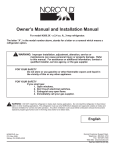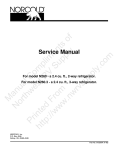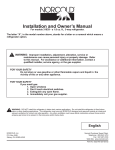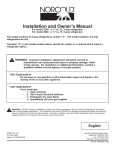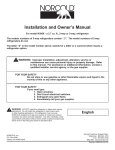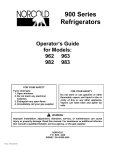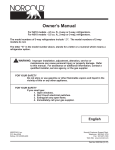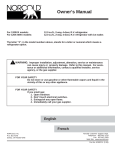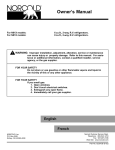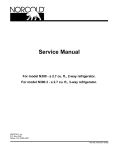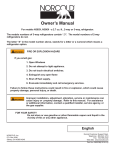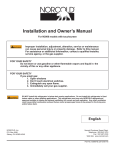Download Norcold N260 User's Manual
Transcript
Owner’s Manual and Installation Manual For model N260 - a 2.4 cu. ft., 2-way or 3-way, refrigerator. WARNING: Improper installation, adjustment, alteration, service or maintenance can cause injury or property damage. Refer to this manual. For assistance or additional information, contact a qualified installer, service agency, or the gas supplier. FOR YOUR SAFETY Do not store or use gasoline or other flammable vapors and liquid in the vicinity of this or any other appliance. FOR YOUR SAFETY If you smell gas: 1. Open windows. 2. Don’t touch electrical switches. 3. Extinguish any open flame. 4. Immediately call your gas supplier. WARNING: DO NOT install this refrigerator in below deck marine applications. Do not install this refrigerator in fixed indoor cabin or other dwelling applications. This refrigerator must use only NORCOLD designed and approved outside air intake and exhaust ventilation for correct and safe operation. Any other ventilation could cause lethal combustion exhaust fumes and/or explosive propane gas fumes to be in the living area and/or to be below deck. NORCOLD, Inc. P.O. Box 4248 Sidney, OH 45365-4248 English French Norcold Customer Support Dept. Telephone: 800-543-1219 Fax: 937-497-3183 Web Site: www.norcold.com Part No. 620292F (11-01) NORCOLD - Gas Absorption 3 Year Limited Warranty Policy Table of Contents Owner‘s Manual ........................................................................ 2 Norcold • P.O. Box 4248 • Sidney, OH • USA • 45365-4248 Gas Absorption 3 Year Limited Warranty Policy ......................... Gas Absorption Warranty Information ........................................ Gas Absorption Warranty Questions .......................................... Safety Awareness ....................................................................... Safety Instructions ...................................................................... About Your Refrigerator .............................................................. Storage volume ............................................................ Leveling ........................................................................ Operation during travel ................................................ Food compartment ...................................................... Travel latch ................................................................... Storage latch ................................................................ Ignition and Start Up ................................................................... Controls ........................................................................ Ignition - propane gas operation ................................. Do a test of the gas safety valve .................................. Start Up - AC operation ................................................. Start Up - DC operation (3-way models only) .............. DC operation precautions ........................................... DC operation guidelines ............................................. Shut down .................................................................... Refrigerator Care Checklist ....................................................... Defrosting and Cleaning ............................................................ Defrosting ..................................................................... Cleaning ....................................................................... Door Sealing .............................................................................. Refrigerator Maintenance Checklist .......................................... Refrigerator Maintenance ........................................................... Gas flame appearance ................................................ Remove and clean the burner orifice .......................... Remove the Refrigerator ............................................................ Reinstall the Refrigerator ........................................................... Wiring Pictorial ........................................................................... Wiring Diagram .......................................................................... Replacement Parts .................................................................... 2 3 3 4 4 4 4 4 4 5 5 5 5 5 5 6 6 6 6 6 6 6 7 7 7 7 7 7 7 8 8 8 9 9 9 Installation Manual ................................................................... 9 Safety Awareness ....................................................................... 9 Safety Instructions ...................................................................... 9 Certification and Code Requirements ..................................... 10 Ventilation Requirements ......................................................... 10 Assemble the Enclosure ........................................................... 11 Install the Lower and Upper Vents ............................................ 11 Reverse the Door Swing (optional) ........................................... 11 Install the Refrigerator .............................................................. 12 Connect the Electrical Components ........................................ 12 Connect the 120 volts AC supply ............................... 12 Connect the 12 volts DC supply (3-way models only) 12 Connect the chassis ground ..................................... 12 Connect the Propane Gas Components ................................. 12 Connect the propane gas supply system ................. 12 Examine the propane gas supply system for leaks .. 13 Provided it is properly installed, properly maintained and placed under normal service and use, Norcold, Inc. warrants its refrigeration equipment to be free from defects in material and workmanship for three years with respect to the equipment’s component parts, and for two years with respect to the labor to repair or replace such parts, commencing from the original date of purchase. Limitations of warranty 1. This Warranty applies only to Norcold gas absorption refrigerator operating equipment. This Warranty does not extend to glassware, electric light bulbs, and replaceable fuses. 2. This warranty does not apply to parts and assemblies that have been subjected to misuse, improper installation, improper or abnormal service, transit damage, recharging of the cooling system, accident, fire, improper repair, tampering or abuse. 3. Irrespective of the nature of the warranty protection offered or claimed, the period of warranty shall in no case extend beyond three years for component parts and two years for the labor to repair or replace such parts, commencing from the original date of purchase of the new equipment. 4. In order to obtain the remedy of repair and replacement, the refrigerator must be brought to any Norcold Service Center for warranty service. The end consumer is responsible for all expenses resulting from any remote service call if the refrigerator cannot be brought into the Norcold service center. 5. It is the responsibility of the end consumer to have maintenance performed upon the warranted equipment one time during the second year or before the beginning of the third year after original purchase. Such maintenance is required to maintain this warranty in effect and failure to perform such maintenance will void the remainder of the warranty. Required maintenance during the second year or before the third year after purchase is cleaning and checking of the following: Burner, Flue, Spiral Baffle, Roof Cap Screen, and Control Board Sequence. Limitation of remedy 1. The responsibility of Norcold under this or any warranty is limited to the repair or replacement (at Norcold’s option) of the defective part or assembly. 2. In no event and under no circumstances shall Norcold be responsible under this limited warranty for any other charge whatsoever, including but not limited to charges or claims for labor, lost business, lost time, lost profits, loss of use, or any kind of incidental or consequential damages, however denominated or described. The remedy under this warranty is limited to replacement or repair. Installation and Owner’s Manual 2 3. Some states do not allow the exclusion or limitation of incidental or consequential damages, so the above exclusion may not apply to you. Disclaimer of other warranties This warranty is expressly in lieu of all other warranties either expressed or implied. All other warranties, expressed or implied, including any warranty of merchantability or fitness for a particular purpose, are hereby disclaimed and excluded. Legal rights This warranty gives you specific legal rights, and you may have other legal rights, which vary from state to state. Gas Absorption Warranty Information Your refrigerator is made to provide the ultimate in cooling satisfaction and will serve you reliably in the years to come. Norcold refrigerators are the only RV refrigerators made in the United States and offer a standard limited three-year warranty. Norcold also offers an additional warranty coverage plan which extends the standard limited three-year warranty. To activate your three-year limited warranty and to receive an invitation to participate in the extended warranty plan, complete and mail the warranty registration supplied. Help us to help you. Write the model number and serial number below for future reference. These numbers are on the serial plate in the refrigerator. The serial plate is located in the fresh food compartment on the top right hand side. Use these numbers when receiving service or in any correspondence concerning your refrigerator. Model number ___________ Serial number ___________ If a problem occurs with your refrigerator, contact any of the service centers throughout the United States and Canada. To find an authorized Norcold Service Center near you, please telephone the Norcold Customer Support Dept. at 800-5431219 (option-1) or visit our web site at www.norcold.com. Norcold is committed to providing products that are in harmony with the environment. Your Norcold refrigerator meets all environmental safety standards. Gas Absorption Warranty Questions This warranty is the only warranty for your Norcold refrigerator. There are no other express warranties. The only uses for this product are described in this manual. Part or model specifications are subject to change without notice. What does this warranty cover? This warranty covers labor and U.P.S. ground transportation costs incurred in removing and reinstalling the refrigerator when necessary to replace a defective part and any parts replaced under warranty (including cooling units). What is not covered by this warranty? - Travel expenses for bringing the refrigerator to an authorized Norcold Service Center for warranty coverage. - Additional costs caused by the inability to bring the refrigerator to an authorized Norcold Service Center. - Defects which are caused by transit damage, misuse, neglect, or accident. - Manufacturing defects found at the time of purchase, parts replaced under warranty, and associated labor, which the original consumer-purchaser do not communicate to Norcold within 30 days. - Labor, performed without need for parts replacements, which the original consumer-purchaser does not communicate to Norcold within 30 days. - Defects in glassware, electric light bulbs, or replacement fuses. - Defects caused by improper installation, maintenance, or adjustment. - Normal maintenance of this refrigerator as described in this manual. - Defects caused by the improper use of parts or parts not manufactured or supplied by Norcold for repairs or replacements to the refrigerator. Norcold will not be liable for any incidental or consequential loss or damage, due directly or indirectly to the use of this product. Some states do not allow the exclusion or limitation of incidental or consequential damages, so the above may not apply to you. How long does this warranty last? This warranty is effective for a period of two years from date of purchase or for a period of three years from date of puchase if the required maintenance is done. What will Norcold do? Norcold will provide free service and replacement of defective parts, at no charge, at all authorized Norcold Service Centers. Norcold has the option of replacing the defective parts or the entire refrigerator. If the refrigerator is replaced, Norcold is not responsible for replacing dealer installed options. How do you get service? Bring the refrigerator to any authorized Norcold Service Center and: - Show proof that the defective item is within warranty coverage. - Show proof that required maintenance has been performed if applicable. Required maintenance during the second year or before the third year after purchase is cleaning and checking of the Burner, Flue, Spiral Baffle, Roof Cap Screen, and Control Board Sequence. If you are unable to bring the refrigerator to an authorized Norcold Service Center: - Send a written notice of the defect to Norcold. - Norcold will promptly advise you how to obtain warranty service. What rights do you have? This warranty gives you specific legal rights. You may also have other rights which vary from state to state. Installation and Owner’s Manual 3 Safety Awareness Read this manual carefully and understand the contents before you use the refrigerator. Be aware of possible safety hazards when you see the safety alert symbol on the refrigerator and in this manual. A signal word follows the safety alert symbol and identifies the danger of the hazard. Carefully read the descriptions of these signal words to fully know their meanings. They are for your safety. - The refrigerator cooling system is under pressure. Do not try to repair or to recharge a defective cooling system. The cooling system contains sodium chromate. The breathing of certain chromium compounds can cause cancer. The cooling system contents can cause severe skin and eye burns, and can ignite and burn with an intense flame. Do not bend, drop, weld, move, drill, puncture, or hit the cooling system. CAUTION: ignored, can cause dangerous personal injury, death, or much property damage. - The rear of the refrigerator has sharp edges and corners. To prevent cuts or abrasions when working on the refrigerator, be careful and wear cut resistant gloves. CAUTION: This signal word means a hazard, which if ignored, can cause small personal injury or much property damage. - Make sure all fasteners and connections are tight. WARNING: This signal word means a hazard, which if Safety Instructions WARNING: - The storage of flammable materials behind or around the refrigerator creates a fire hazard. Do not use the area behind the refrigerator to store flammable materials (gasoline, cleaning supplies, etc.) - Do not remove the round ground prong from the refrigerator AC power cord. Do not use a two prong adapter or extension cord on the AC power cord. - A circuit overload can result in an electrical fire if the wires and/or fuses are not the correct size. Either use the wire and fuse sizes as writtten in the “Installation Manual” or refer to your local codes or the applicable RVIA Standards for the correct wire and fuse sizes. - Incorrect installation, adjustment, change to, or maintenance of this refrigerator can cause personal injury, property damage, or both. Have service and maintenance work done by your dealer or by an Norcold authorized service center. About Your Refrigerator Storage Volume: This refrigerator is made for food storage. Total capacity ....................................................... 2.4 cubic feet Leveling: CAUTION: The refrigerator is made to operate within 3° off level side-to-side and 6° off level front-to-back (as looking at the front of the refrigerator). Operating it at more than these limits can cause damage to the cooling system and create a risk of personal injury or property damage. Make sure the vehicle is level before you operate the refrigerator. Operation during travel: While the refrigerator should be level when the vehicle is stopped, performance during travel is not usually effected. Food compartment: - Disconnect both the AC and DC power sources before doing any maintenance work on the refrigerator. All service work on this refrigerator must be done by a qualified service technician. Ignite or start up the refrigerator and let it cool for eight hours before loading with food. If the refrigerator does not start to cool down after about two hours, contact your dealer or a Norcold authorized service center. - Do not bypass or change the refrigerator’s electrical components or features. For the best cooling performance: - When you discard an appliance, remove all doors to prevent accidental entrapment and suffocation. - Do not spray liquids near electrical outlets, connections, or the refrigerator components. Many liquids are electrically conductive and can cause a shock hazard, electrical shorts, and in some cases fire. - Let air move freely inside the entire food compartment. - Do not cover the shelves with plastic, paper, etc. To decrease the amount of ice that forms on the cooling fins: - Cover all liquids and moist foods. - Let hot foods cool before putting them in the refrigerator. - Do not open the door any longer than necessary. Installation and Owner’s Manual 4 Travel latch: Ignition and Start Up NOTE: During daily use, turn the travel / storage latch so that is parallel with the edge of the door (See Art01101). Controls: Use the travel latch feature to lock the refrigerator door in the closed position. When you engage the travel latch, the door cannot accidentally open during travel. To engage the travel latch: 1. Open the door [1] of the refrigerator (See Art01102). 2. Turn the travel / storage latch [2] so it is parallel with the edge of the door. 3. Close the door of the refrigerator. 4. Push the door closed to compress the gasket and turn the travel / storage latch into the slot of the metal refrigerator frame [3]. 5. Continue to turn the travel / storage latch until the ball shaped stop [4] engages the ball shape [5] of the metal refrigerator frame. To disengage the travel latch: 1. Push the door closed to compress the gasket and turn the travel / storage latch until the ball shaped stop disengages the ball shape of the metal refrigerator frame. 2. Continue to turn the travel / storage latch so it comes out of the slot in the metal frame and is parallel with the edge of the door. 3. Open the door of the refrigerator. Storage latch: Thermostat ........................................................................... 1 Selector switch ..................................................................... 2 Gas safety valve .................................................................. 3 Piezo lighter .......................................................................... 4 The thermostat [1] changes the amount of propane gas that goes to the burner (See Art01029). This acts as the temperature control of the refrigerator. Number 5 is the coldest temperature setting. NOTE: This is not an automatic gas control. It does not change the flame from high fire to low fire as do some RV refrigerators. If the cooling load changes, you must manually change the gas control to maintain the same temperature inside the refrigerator. When the outside air temperature is less than 50° F, the refrigerator may have a tendency to freeze food at the colder temperature settings. To reduce the tendency to freeze food: Use the storage latch feature to prevent the build up of odors when the refrigerator is shut down for a long period of time. When you engage the storage latch, the refrigerator door will not be fully closed. - Turn the thermostat to a warmer temperature setting. To engage the storage latch: - Put foods that are more likely to freeze on the upper shelf. 1. Open the door [1] of the refrigerator enough to break the seal of the gasket (Art01103). 2. Turn the travel / storage latch [2] into the slot of the metal refrigerator frame [3]: - Make sure the groove [6] in the travel / storage latch engages the edge [7] of the metal refrigerator frame. - Keep the refrigerator full. The selector switch [2] changes the energy source of the refrigerator between propane gas ( ), AC electric ( ), and DC electric ( ) (3-way models only) and shuts down the refrigerator at the OFF ( ) position. To disengage the storage latch: The gas safety valve [3] is built into the control panel. As long as a flame is present, the valve is open and allows propane gas to flow into the burner. Any loss of flame (empty gas tank, blow out, etc.) closes and stops the flow of propane gas. 1. Turn the travel / storage latch out of the slot of the metal refrigerator frame: The igniter [4] makes a spark which ignites the flame in the burner. 2. Close the door of the refrigerator. Ignition - propane gas operation: 1. Open the valve at the propane gas storage tank. 2. Turn the thermostat to the coldest temperature setting. Installation and Owner’s Manual 5 3. Turn the selector switch to the propane gas position ( ). 4. Push and hold in the safety valve and in rapid succession, push in the igniter several times for about five seconds. WARNING: Do not hold in the safety valve for more than 30 seconds. If there is no flame in this time, wait at least five minutes before you try ignition again. If you continue to hold in the safety valve, gas will collect in the burner area. This could cause a fire or explosion and result in dangerous personal injury or death. - Open the burner box door and look for the flame. Keep in mind the following electrical precautions for DC operation of the refrigerator: - Good battery condition is necessary for correct DC operation. - The capacity of the battery charging system must be more than what is necessary for the refrigerator and other DC appliances. - While the vehicle engine is running, have a qualified service technician make sure the voltage of the DC power supply leads at the refrigerator is more than 11.5 VDC. - When the flame ignites, release the safety valve. DC operation guidelines: - If the flame does not ignite, wait about five minutes and do this step again. DC operation is intended only to maintain the temperature of the refrigerator and its contents when they are already cool. With an established flame in GAS mode: The DC operation is not intended for the initial start up and cooling of the refrigerator. Always use either the AC operation or propane gas operation to initially start up and cool the refrigerator. The refrigerator must be cooled and the temperature must be steady before you operate the refrigerator on DC. 1. Close the manual gas shutoff valve [2] of the refrigerator (See Art01035]. Keep in mind the following guidelines for DC operation of the refrigerator: 5. Turn the thermostat to the temperature setting that you wish. Do a test of the gas safety valve: 2. After the flame is extinguished, you should hear a sharp “click” sound within three minutes. - Use DC operation of the refrigerator only while the vehicle is in transit. NOTE: The gas safety valve should close with a sharp “click“ sound. - Do not use DC operation until the refrigerator and its contents are completely cooled. 3. Open the manual gas shutoff valve of the refrigerator. 4. Without pushing in the gas control, push the igniter several times rapidly in succession. The burner flame should not ignite. This means that the gas safety valve is working correctly. Start up - AC operation: ). - Turn the thermostat to the temperature setting that you wish. Start up - DC operation (3-way models only): ). DC operation precautions: This refrigerator is made to operate on DC power while your vehicle is “in transit” and AC power or propane gas sources are not available. Operate the refrigerator on DC power only when the vehicle engine is running. For the refrigerator to operate correctly on DC power, the battery must be maintained in a fully charged condition. For the battery to be fully charged at all times during refrigerator operation on DC, the vehicle engine must be running and the alternator must be in good operating condition. Installation and Owner’s Manual 6 ). Refrigerator Care Checklist - Keep the food compartment clean. See “Defrosting and Cleaning”. - Defrost the refrigerator as necessary. See “Defrosting and Cleaning”. - Make sure the door seals correctly. See “Door Sealing“. - Make sure that 12 volts DC is available. - Turn the selector switch to the DC position ( - Turn the selector switch to the OFF position ( Your refrigerator will give you years of trouble free service if you do these simple checks every three to six months: - Make sure that 120 volts AC is available. - Turn the selector switch to the AC position ( Shut down: - Be aware of any cooling changes that are not because of weather, loading, or thermostat changes. If changes occur, contact your dealer or service center. - Make sure the gas supply is propane gas only and is not butane or a butane mixture. - When in propane gas operation, examine the appearance of the flame. See “Gas Flame Inspection”. - Make sure the air flow in the lower intake vent, through the refrigerator coils and condenser, and out the upper exhaust vent is not blocked or decreased. - Make sure the area behind the refrigerator is clear. Do not use the area behind the refrigerator for storage of any combustible materials, especially gasoline and other flammable vapors and liquids. Defrosting and Cleaning Defrosting: It is normal for frost to collect on the cooling fins inside the refrigerator. Excess frost decreases the cooling performance of the refrigerator. To defrost the refrigerator as necessary: - Turn the thermostat to the 1 position and the energy selector to the OFF position ( ). - Remove all food from the refrigerator. NOTE: Defrosting the refrigerator makes excess water inside the refrigerator. - Put dry towels (etc.) inside the refrigerator to absorb the water. - Put trays of hot water in the refrigerator until the frost is melted. - Remove the wet towels (etc.) and dry the interior. - Put all food in the refrigerator. - Do the ignition procedure or start up the refrigerator. Cleaning: A good time to clean the refrigerator is just after you defrost it. To avoid food odors, clean the inside of the refrigerator as often as necessary: - Remove all food from the refrigerator. NOTE: Do not use abrasive cleaners, chemicals, or scouring pads because they can damage the interior of the refrigerator. - Wash the interior with a solution of dish detergent and warm water. - Rinse with a solution of baking soda and clean water. - Dry with clean cloth. Refrigerator Maintenance Checklist Read and understand the following maintenance sections of this manual. NOTE: Norcold is not responsible for installation, adjustment, alteration, service, or maintenance performed by anyone other than a qualified RV dealer or a Norcold authorized service center. Have a qualified RV dealer or a Norcold authorized service center do these annual safety and maintenance checks: - Examine the gas supply lines for leaks. - Replace or repair if necessary. - Make sure the propane gas pressure is correct. - Adjust if necessary. - Make sure the combustion seal is complete and intact. - Replace or repair it if necessary. - Make sure the burner and the burner orifice are clean. - Clean if necessary. - Make sure the electrode spark gap [3] is 1/8 - 3/16 inch (See Art00955). - Adjust if necessary. - Make sure the AC and DC voltages are correct. - Adjust if needed. - Make sure the thermocouple tip is clean and secure. - Make sure the area at the rear of the refrigerator is free from any combustible materials, especially gasoline and other flammable vapors and liquids. Refrigerator Maintenance - Put all food in the refrigerator. Door Sealing Gas flame appearance: While in propane gas operation, examine the gas flame: If the door does not seal correctly, excess frost will collect inside the refrigerator. Make sure the door seals correctly: - Close the door on a piece of paper that is about the size and thickness of a dollar bill (See Art00980). - Gently pull the paper. - You should feel a slight drag between the door gasket and the cabinet. - Do this on all four sides of the door. - If you do not feel drag on the paper, the door gasket is not sealing correctly. - Contact your dealer or Norcold authorized service center. - Open the lower intake vent. - Turn the thermostat to the 5 position. CAUTION: The burner box cover can be hot. Wear gloves to avoid burns. - Open the burner box door [3] and look at the gas flame [1] (See Art01035 and Art00955). - The flame should be a darker blue inside and a lighter blue outside and should be a constant and steady shape. - If the flame is yellow or has an erratic and unstable shape, contact your RV dealer or Norcold authorized service center. Installation and Owner’s Manual 7 - Make sure the flame does not touch the inside of the flue tube [2]. - If the flame touches the inside of the flue tube, contact your dealer or Norcold authorized service center. - Close the burner box door. Remove and clean the burner orifice: 3. Remove the AC power cord from the receptacle. - On 3-way models only, mark the DC wires so you can put them back in the correct location. - Remove the DC fuse or remove the DC wiring from the battery or the converter of the vehicle. - Remove the DC wires from the refrigerator. NOTE: A dealer or Norcold authorized service center must do this procedure. 4. Remove the screws which attach the rear of the refrigerator to the floor. To remove and clean the burner orifice: 5. Remove the screws which attach the refrigerator to the wall. - Close the valve at the gas tank(s). 6. Remove the refrigerator. - Close the manual shut off valve of the refrigerator. - Turn the thermostat to the 1 position and the energy selector to the OFF positon ( ). CAUTION: The burner box cover can be hot. Wear Reinstall the Refrigerator NOTE: A dealer or Norcold authorized service center must do this procedure. gloves to avoid burns. - Open the lower intake vent. - Remove the flare nut from the orifice assembly [1] (See Art00956). - Remove the orifice assembly from the burner [2] WARNING: When cleaning, do not try to remove the orifice [3] from the orifice adapter [4]. Removal will damage the orifice and seal of the orifice and can cause a propane gas leak. Leaking propane gas can ignite or explode and result in dangerous personal injury or death. Do not clean the orifice with a pin or other objects. - Clean the orifice assembly with air pressure and alcohol only. - Using a wrench, assemble the orifice assembly to the burner. - Assemble the flare nut to the orifice assembly. - Examine all of the gas connections for leaks. Remove the Refrigerator WARNING: Make sure the seal strips are not broken, are completely around the refrigerator mounting flanges, and are between the refrigerator mounting flanges and the wall of the enclosure. If the seal is not complete, exhaust fumes can be present in the living area of the vehicle. The breathing of exhaust fumes can cause dizziness, nausea, or in extreme cases, death. 1. Push the refrigerator completely into the enclosure. 2. Put the screws though the mounting flanges and into the wall. CAUTION: The rear of the refrigerator has sharp edges and corners. To prevent cuts or abrasions when working on the refrigerator, be careful and wear cut resistant gloves. 3. Open the lower intake vent and put the screws through refrigerator and into the floor. WARNING: To avoid possible gas leaks, always use two wrenches to tighten or loosen the LP gas supply line at the refrigerator’s manual shut off valve 4. Attach the gas supply line to the manual shut off valve of the refrigerator. 5. Open the valve at the propane gas tank(s). NOTE: A dealer or Norcold authorized service center must do this procedure. CAUTION: The rear of the refrigerator has sharp edges and corners. To prevent cuts or abrasions when working on the refrigerator, be careful and wear cut resistant gloves. 1. Close the valve at the propane gas tank(s). WARNING: To avoid possible gas leaks, always use two wrenches to tighten or loosen the gas supply line at the manual shutoff valve of the refrigerator. WARNING: Do not allow the leak detecting solution to touch the electrical components. Many liquids are electrically conductive and can cause a shock hazard, electrical shorts, and in some cases fire. 6. Using a leak detecting solution, examine the gas supply line for leaks. 7. Connect the DC wiring to the refrigerator: - Install the DC fuse and connect the DC wiring to the battery or the converter. - Connect the DC wires from the refrigerator. 2. Open the lower intake vent and remove the gas supply line from the manual shut off valve of the refrigerator. Installation and Owner’s Manual 8 8. Connect the AC power cord to the receptacle. Installation Manual Wiring Pictorial The parts or the wiring pictorial are (See Art01022): 1. .......................................................... 120 VAC Power cord 2 .................................................................... Chassis ground 3 ............................................................................ Interrupter 4 .......................................................................... 3 Amp fuse 5 ............................................................................ AC heater 6 ................................................................................. Jumper 7 ..................................................................... Terminal block 8 ............................................. Thermostat / gas safety valve 9 .................................................................... Selector switch 10 ..................................... 20 Amp fuse (3-way models only) 11 ...................... 12 VDC Power supply (3-way models only) 12 ......................................... DC heater (3-way models only) Safety Awareness Read this manual carefully and understand the contents before you install and operate the refrigerator. Be aware of possible safety hazards when you see the safety alert symbol on the refrigerator and in this manual. A signal word follows the safety alert symbol and identifies the danger of the hazard. Carefully read the descriptions of these signal words to fully know their meanings. They are for your safety. WARNING: This signal word identifies a hazard, which if ignored, can cause dangerous personal injury, death, or much property damage. CAUTION: This signal word identifies a hazard, which if ignored, can cause small personal injury or much property damage. Wiring Diagram The parts of the wiring diagram are (See Art01023): 1. ............................................................................. 120 VAC 2 .......................................................................... 3 Amp fuse 3 .......................................................................... Thermostat 4 ............................................................................ AC heater 5 .............................................................................. 120 VAC 6 ............................................................................ AC ground 7 ............................................................................ Spark gap 8 ......................................................................... Piezo lighter 9 .................................................................. Gas safety valve 10 .................................................................... Thermocouple 11 .................................................. Thermocouple interrupter 12 .......................................... +12 VDC (3-way models only) 13 ..................................... 20 Amp fuse (3-way models only) 14 ........................................ DC heater (3-way models only) 15 ........................................... -12 VDC (3-way models only) WARNING: - This refrigerator is equipped for the use of propane gas only and can not be changed to use any other fuels (natural gas, butane, etc.). - Incorrect installation, adjustment, changes to, or maintenance of this refrigerator can cause personal injury, property damage, or both. - Obey the instructions in this manual to install the intake and exhaust vents. - Do not install the refrigerator directly on carpet. Put the refrigerator on a metal or wood panel that extends the full width and depth of the refrigerator. Replacement Parts You may purchase these items through your local RV dealer or authorized Norcold Service Center. Item Safety Instructions Part Number Door Bin (small) ......................................................... 619242 Door Bin (large) .......................................................... 619235 Door Gasket ............................................................... 619233 Wire Shelf (small) ....................................................... 619237 Wire Shelf (large) ....................................................... 619236 Selector switch (knob only) ....................................... 619070 Thermostat (knob only) ............................................. 919069 Installation and Owner’s Manual ............................. 620292 3 Amp Fuse (AC) ................................................... 61654622 20 Amp Fuse (DC) (3-way models only) .............. 61440522 NOTE: These fuses (type 3AG - 1 1/4 in. x 1//4 in.) are available at most auto supply stores. - Propane gas can cause a fire or an explosion that can result in property damage, personal injury, or death. Do not smoke or create sparks while doing any work on the propane gas supply system. Do not use an open flame to examine the gas supply piping or fittings for leaks. - To avoid possible propane gas leaks, always use two wrenches to tighten or loosen the gas supply line connections. - Make sure the electrical installation obeys all applicable codes. See the “Certification and Code Requirements” section of this manual. - Do not bypass or change the refrigerator’s electrical components or features. - Do not spray liquids near electrical outlets, connections, or the refrigerator components. Many liquids are electrically conductive and can cause a shock hazard, electrical shorts, and in some cases fire. Installation and Owner’s Manual 9 - The refrigerator cooling system is under pressure. Do not try to repair or to recharge a defective cooling system. The cooling system contains sodium chromate. The breathing of certain chromium compounds can cause cancer. The cooling system contents can cause severe skin and eye burns, and can ignite and burn with an intense flame. Do not bend, drop, weld, move, drill, puncture, or hit the cooling system. All propane gas supply piping and fittings must obey local, state, and national codes about type and size. These components must also obey the current NFPA 501C section 24, and in Canada, the current CAN 1-6.10 Standard. Ventilation Requirements CAUTION: WARNING: The completed installation must: - The rear of the refrigerator has sharp edges and corners. To prevent cuts or abrasions when working on the refrigerator, be careful and wear cut resistant gloves. - Make sure there is sufficient intake of fresh air for combustion. - Make sure the living space is completely isolated from the combustion system of the refrigerator. Certification and Code Requirements This refrigerator is certified under the latest edition of ANSI Z21.19 Standards by the American Gas Association for installation in mobile homes or recreational vehicles and is approved by the Canadian Gas Association. The installation must obey these standards and this “Installation Manual” for the NORCOLD limited warranty to be in effect. Installation must obey local codes. In the absence of local codes, the installation must obey these standards: - Make sure there is complete and unrestricted ventilation of the flue exhaust which, in gas mode, can produce carbon monoxide. The breathing of carbon monoxide fumes can cause dizziness, nausea, or in extreme cases, death. Certified installation needs one lower intake vent and one upper exhaust vent. Install the vents through the side wall of the vehicle exactly as instructed in this manual. Any other installation method voids both the certification and the factory warranty of the refrigerator. The bottom of the opening for the lower intake vent, which is also the service access door, must be even with or immediately below the floor level. This allows any leaking propane gas to escape to the outside and not to collect at floor level. In the United States: American Gas Association/Canadian Gas Association (AGA/ CGA) certification allows the refrigerator to have zero (0) inch minimum clearance at the sides, rear, top, and bottom. While there are no maximum clearances specified for certification, the following maximum clearances are necessary for correct refrigeration: - National Fuel Gas Code, ANSI Z223.1. Bottom 0 inch min. 0 inch max. - Manufactured Home Construction and Safety Standard, Title 24 CFR, Part 32-80. Each Side 0 inch min 1/2 inch max. Top 0 inch min. 1/4 inch max. Rear 0 inch min. 1 inch max. - Standard for Recreational Vehicles, RVIA A119.2 latest edition. - For installations which need an electric outlet that is energized by an external power source, the refrigerator must be electrically grounded as written in local or state codes, the National Electrical code, and ANSI/NFPA 70. In Canada: - Current CGA B149.1 and CGA B149.2 Installation code for Propane Appliances and Equipment. - Current CSA Z240.4.2 Installation Requirement for Propane Appliances and Equipment in Recreational Vehicles. - Current CSA Z240.6.2/C22.2 No. 148 Electrical Requirement for Recreational Vehicles. - When installed, the refrigerator must be electrically grounded as written in local or state codes and the Canadian Electrical Code C22.2. Parts 1 and 2. Installation and Owner’s Manual 10 These clearances plus the lower and upper vents cause the natural air draft that is necessary for good refrigeration. Cooler air goes in through the lower intake vent, goes around the refrigerator coils where it removes the excess heat from the refrigerator components, and goes out through the upper exhaust vent. If this air flow is blocked or decreased, the refrigerator may not cool correctly. Each NORCOLD model is certified by AGA and CGA for correct ventilation. - Install a baffle [6] to prevent stagnant hot air in the area [7] above the refrigerator (See Art01028). Assemble the Enclosure - Make sure the enclosure is 21 inches high x 19 3/8 inches wide x 24 inches deep. - Make sure there is less than 1/4 inch clearance [8] between the baffle and the top of the refrigerator. - Make sure the floor is solid and level. - Make sure the baffle is the full width of the inside of the enclosure. - The floor must be metal or a wood panel and extend the full width and depth of the enclosure. - The floor must be able to support the weight of the refrigerator and its contents. - Make sure there are no adjacent heat sources such as a furnace vent, etc. Install the Lower and Upper Vents - If the distance from the back of the refrigerator to the wall of the vehicle is more than one inch, install a baffle [9] at the top of the intake vent between the back of the refrigerator and the wall of the vehicle. Reverse the Door Swing (optional) This refrigerator has door hinges that allow you to change the direction that the door opens by moving the hinges on a diagonal to the opposite side. (See Art01031) 1. Determine the rough opening (RO) size for each vent. Certified Vent Part No. RO High RO Wide Upper Exhaust Vent 617485 7 1/4 in. 18 in. Lower Intake Vent 617484 9 3/4 in. 19 3/8 in. 2. Install the lower intake vent (See Art01026): WARNING: Make sure the bottom of the opening for the lower intake vent is even with or immediately below the floor level. This allows any leaking propane gas to escape to the outside and not to collect at floor level. - Make sure the bottom of the opening of the lower intake vent [1] is even with or immediately below the floor level. - Align the lower intake vent vertically below the coils [2] and the condenser [3] of the refrigerator. 3. Install the upper exhaust vent (See Art01036): - Make sure the distance [4] from the floor level to the top of the rough opening for the upper exhaust vent is at least 20 5/8 inches or poor cooling performance can occur. - Align the upper exhaust vent [5] vertically above with the coils and in line with the condenser of the refrigerator. - For the best cooling performance and if the construction of the vehicle allows, the distance [4] from the floor level to the top of the rough opening of the upper exhaust vent [5] should be as near 30 1/2 inches as possible (See Art01027). - Align the upper exhaust vent [5] vertically above the coils [2] and the condenser [3] of the refrigerator. 1. Remove the door: - Remove the storage bins from the door. - Turn out and save the upper hinge pin [1]. - Open the door a small amount and pull the top of the door away from the upper hinge of the refrigerator. - Lift the door off [2] of the lower hinge pin [3]. - Turn out and save the lower hinge pin. 2. Change the position of the hinges: - Remove the screws from the front of the breaker [4]. - Remove the breaker. - Remove the screws [5] from the upper hinge [6]. - Put this hinge on the other side as the lower hinge. - Attach the hinge with the screws. - Turn the lower hinge pin down into this hinge. - Remove the screws [5] from the lower hinge [7]. - Put this hinge on the other side as the upper hinge. - Attach the hinge with the screws. - Turn the breaker over and assemble it to the front of the refrigerator. 3. Install the door: - Turn the door over. - Put the door down onto the lower hinge pin. - Align the holes in the upper hinge and the hinge bushing and hold in ths position. - Screw the upper hinge pin down into the upper hinge and into the door. - Put the storage bins in the door. Installation and Owner’s Manual 11 Install the Refrigerator WARNING: Make sure the seal strips are not broken, are completely around the refrigerator mounting flanges, and are between the refrigerator mounting flanges and the wall of the enclosure. If the seal is not complete, exhaust fumes can be present in the living area of the vehicle. The breathing of exhaust fumes can cause dizziness, nausea, or in extreme cases, death. - Put screws through the refrigerator mounting flanges and into the wall of the enclosure. - Put screws through the braces at the lower rear corners of the refrigerator and into the floor. Connect the Electrical Components AC Operation Current Draw: DC Operation (3-way models only) Current Draw: 120 volts AC voltage ( 108 volts min. - 132 volts max.) 1.3 Amps at 110 volts AC 1.4 Amps at 120 volts AC 12 volts DC voltage (11.5 volts min. - 15.4 volts max.) 11.7 Amps at 12 volts DC 13.6 Amps at 14 volts DC This refrigerator operates on these electrical sources. Operation out of these limits may damage the refrigerator’s electrical circuit parts and will void the warranty. Connect the 120 volts AC supply: WARNING: Connect the AC power cord only to a grounded three-prong receptacle. Do not remove the round ground prong from the power cord. Do not use a two-prong adapter or an extension cord. Operation of the refrigerator without a correct ground could cause dangerous electrical shock or death if you are touching the metal parts of the refrigerator or the vehicle. 1. For the best performance, Norcold recommends that you use the following wire and fuse sizes: - Measure the distance from the vehicle battery to the refrigerator: - If the distance is 0 - 20 feet, use #12 AWG min. wire size and a 20 amp Max. fuse. - If the distance is more than 20 feet, use #10 AWG min. wire size and a 30 amp Max. fuse. The wire connections must be clean, tight and free of corrosion. If any of these items are not correct: - A voltage drop to the refrigerator will occur. - The voltage drop will reduce the cooling performance of the refrigerator. The red wire (+) and the black wire (-) for connecting the DC power supply are attached to the positive (+) and negative (-) terminals of the terminal block of the refrigerator. Make sure that: - Each DC power supply wire is attached to the correct polarity wire. - The chassis or the vehicle frame is not used as one of the conductors. - The DC power supply wires including the fuses are routed directly from the battery to the refrigerator. 2. Connect the D.C. power supply wires: - Attach a 1/4 inch female Quick Connect terminal to each DC power supply wire. - Push each power wire onto the terminal block [1] at the rear of the refrigerator (See Art01035). - Make sure each DC power supply wire is on the correct polarity terminal. Connect the chassis ground: Put the AC power cord into a grounded three-prong receptacle: - Make sure the receptacle is within easy reach of the lower intake vent. - Make sure the power cord does not touch the burner cover, the flue pipe, or any hot component that could damage the insulation of the power cord. Connect a ground wire between the refrigerator and the vehicle chassis: - Use #8 AWG wire with a #8 ring terminal for the ground wire. - Remove the nut and washer from the grounding terminal of the refrigerator. Connect the 12 volts DC supply (3-way models only): - Put the ground wire, the washer, and nut on the terminal. As the distance from the vehicle battery to the refrigerator increases, the correct AWG wire size and fuse size also increase. If the wire size is too small for the distance, a voltage drop occurs. The voltage drop decreases the output of the system heater and causes decreased cooling performance. WARNING: A circuit overload can result if the wires and/ or fuses are not the correct size. Refer to your local codes or the applicable RVIA Standards for the correct wire and fuse sizes. - Tighten the nut. Connect the Propane Gas Components This refrigerator operates on propane gas at a pressure of 11 inches Water Column Propane. Connect the propane gas supply system: WARNING: Be very careful when working on or near the propane gas supply system. Installation and Owner’s Manual 12 - Do not smoke, or use an open flame near the propane gas system. - Do not use an open flame to examine for leaks. - Do not connect the refrigerator to the gas tank without a pressure regulator between them. - To avoid possible propane gas leaks, always use two wrenches to tighten or loosen the gas supply line connections. - Leaking propane gas can ignite or explode and result in dangerous personal injury or death. Connect the gas supply line to the refrigerator: - Make sure all tubing and fittings obey all local, state, and national codes about size and type. - Make sure that all flexible metal connectors obey the current CAN 1-6.10 Standard. - Use 3/8” diameter copper tubing as the gas supply line and use a 3/8” SAE (UNF5/8 -18) female flare fitting as the connection to the refrigerator. - Put the gas supply line up through the floor of the enclosure and in a manner to prevent vibration and abrasion. - Make sure the hole through the floor is large enough to allow clearance for the gas supply line. - Put a weather resistant seal (grommets, sealant, etc.) around the gas supply line where it goes through the floor to prevent vibration and abrasion. - Attach the gas supply line to the bulkhead fitting [2] of the refrigerator (See Art01035). Examine the gas supply system for leaks: WARNING: Do not allow the leak detecting solution to touch the electrical components. Many liquids are electrically conductive and can cause a shock hazard, electrical shorts, and in some cases fire. Using a solution of liquid detergent and water, make sure the gas supply line and all gas connections have no leaks. Do not use any liquid that contains ammonia. If you use compressed air for the test: - The pressure of the compressed air at the manual shutoff valve of the refrigerator must not be more than 1/2 psig (14 inches Water Column). - If the pressure of the compressed air is more than 1/2 psig (14 inches Water Column), remove the gas supply line from the manual shutoff valve of the refrigerator before the test. - If the pressure of the compressed air is equal to or less than 1/2 psig (14 inches Water Column), close the manual shutoff valve of the refrigerator before the test. Installation and Owner’s Manual 13

















